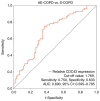Blood CDC42 overexpression is associated with an increased risk of acute exacerbation, inflammation and disease severity in patients with chronic obstructive pulmonary disease
- PMID: 35978930
- PMCID: PMC9366288
- DOI: 10.3892/etm.2022.11481
Blood CDC42 overexpression is associated with an increased risk of acute exacerbation, inflammation and disease severity in patients with chronic obstructive pulmonary disease
Abstract
It has been previously reported that cell division control 42 (CDC42) protein can regulate macrophage recruitment, T cell-associated inflammation and lung injury. However, its role in chronic obstructive pulmonary disease (COPD) remain poorly understood. Therefore, the present study aimed to investigate the possible association among CDC42 expression, the risk of acute exacerbation and disease features in patients with COPD. Peripheral blood mononuclear cells (PBMCs) and serum samples were collected from 60 patients with acute exacerbation COPD (AE-COPD), 60 patients with stable COPD (S-COPD) and 60 healthy control (HCs) individuals. The mRNA expression levels of CDC42 in PBMCs were then measured using reverse transcription-quantitative PCR. The serum levels of TNF-α, IL-1β, IL-6 and IL-17 were measured using ELISA. The results showed that the expression of CDC42 was dysregulated among patients with AE-COPD and S-COPD compared with that in HCs. Specifically, the expression level of CDC42 was the highest in patients with AE-COPD, followed by those with S-COPD and the lowest in HCs (P<0.001). Furthermore, receiver operating characteristic curve analysis demonstrated that CDC42 expression was associated with an increased risk of acute exacerbation in COPD with an area under curve of 0.690 (95% confidence interval=0.595-0.785). CDC42 was found to be positively associated with Global Initiative for Chronic Obstructive Lung Disease staging in patients with AE-COPD (P<0.01) and S-COPD (P<0.05). Additionally, CDC42 expression associated positively with the serum levels of TNF-α, IL-1β, IL-6 and IL-17 in patients with AE-COPD (all P<0.05). However, this association was weaker in patients with S-COPD and became negligible in HCs. In conclusion, data from the present study suggest that CDC42 is associated with an increased risk of acute exacerbation, inflammation and disease severity in patients with COPD, implicating its application as a potential biomarker for COPD.
Keywords: acute exacerbation risk; cell division cycle 2; chronic obstructive pulmonary disease; disease severity; inflammation.
Copyright: © Ming et al.
Conflict of interest statement
The authors declare that they have no competing interests.
Figures




Similar articles
-
Long non-coding RNA PVT1, a novel biomarker for chronic obstructive pulmonary disease progression surveillance and acute exacerbation prediction potentially through interaction with microRNA-146a.J Clin Lab Anal. 2020 Aug;34(8):e23346. doi: 10.1002/jcla.23346. Epub 2020 Apr 27. J Clin Lab Anal. 2020. PMID: 32342557 Free PMC article.
-
Dysregulated circulating microRNA-126 in chronic obstructive pulmonary disease: linkage with acute exacerbation risk, severity degree, and inflammatory cytokines.J Clin Lab Anal. 2022 Mar;36(3):e24204. doi: 10.1002/jcla.24204. Epub 2022 Jan 21. J Clin Lab Anal. 2022. PMID: 35064606 Free PMC article.
-
Long noncoding RNAs antisense noncoding RNA in the INK4 locus (ANRIL) correlates with lower acute exacerbation risk, decreased inflammatory cytokines, and mild GOLD stage in patients with chronic obstructive pulmonary disease.J Clin Lab Anal. 2019 Feb;33(2):e22678. doi: 10.1002/jcla.22678. Epub 2018 Sep 19. J Clin Lab Anal. 2019. PMID: 30230590 Free PMC article.
-
Circulating JNK pathway-associated phosphatase: A novel biomarker correlates with Th17 cells, acute exacerbation risk, and severity in chronic obstructive pulmonary disease patients.J Clin Lab Anal. 2022 Jan;36(1):e24153. doi: 10.1002/jcla.24153. Epub 2021 Dec 16. J Clin Lab Anal. 2022. PMID: 34918391 Free PMC article.
-
Long non-coding RNA NEAT1 predicts elevated chronic obstructive pulmonary disease (COPD) susceptibility and acute exacerbation risk, and correlates with higher disease severity, inflammation, and lower miR-193a in COPD patients.Int J Clin Exp Pathol. 2019 Aug 1;12(8):2837-2848. eCollection 2019. Int J Clin Exp Pathol. 2019. PMID: 31934120 Free PMC article.
References
-
- Lozano R, Naghavi M, Foreman K, Lim S, Shibuya K, Aboyans V, Abraham J, Adair T, Aggarwal R, Ahn SY, et al. Global and regional mortality from 235 causes of death for 20 age groups in 1990 and 2010: A systematic analysis for the global burden of disease study 2010. Lancet. 2012;380:2095–2128. doi: 10.1016/S0140-6736(12)61728-0. - DOI - PMC - PubMed
-
- Global, regional, and national incidence, prevalence, and years lived with disability for 354 diseases and injuries for 195 countries and territories, 1990-2017: a systematic analysis for the global burden of disease study 2017. Lancet. 2018;392:1789–1858. doi: 10.1016/S0140-6736(18)32279-7. GBD 2017 Disease and Injury Incidence and Prevalence Collaborators. - DOI - PMC - PubMed
-
- Ming X, Duan W, Yi W. Long non-coding RNA NEAT1 predicts elevated chronic obstructive pulmonary disease (COPD) susceptibility and acute exacerbation risk, and correlates with higher disease severity, inflammation, and lower miR-193a in COPD patients. Int J Clin Exp Pathol. 2019;12:2837–2848. - PMC - PubMed
LinkOut - more resources
Full Text Sources
Miscellaneous
